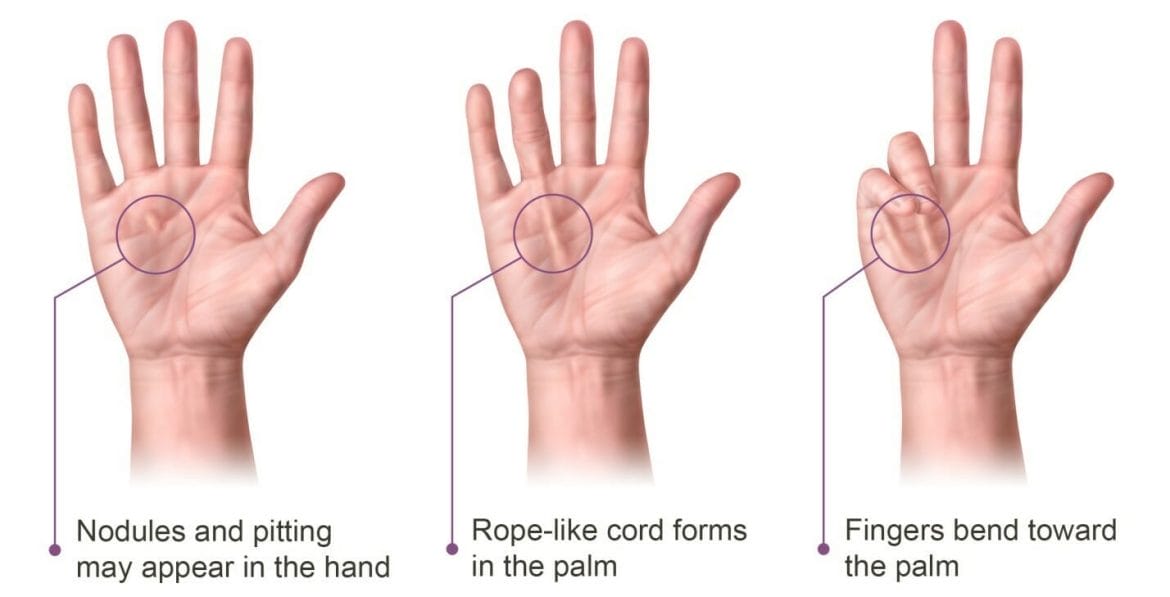Dupuytren’s contracture is a progressive hand condition that can significantly impact daily life, and at Tran Plastic Surgery in Huntington Beach, we specialize in advanced treatment options to restore mobility and hand function. Whether you are in the early stages of Dupuytren’s disease or already experiencing finger contractures, our goal is to provide tailored care that helps you regain confidence and independence.
What is Dupuytren’s Contracture?
Dupuytren’s disease is a condition that affects the connective tissue (fascia) beneath the skin of the palm. Over time, the fascia thickens and tightens, forming rope-like cords that pull the fingers inward toward the palm. This process leads to Dupuytren’s contracture, a condition where fingers commonly the ring and little finger can no longer fully straighten.
While the condition is not life-threatening, it can interfere with essential functions such as grasping objects, shaking hands, typing, or even putting your hand in your pocket. Left untreated, Dupuytren’s contracture may worsen gradually, restricting independence in daily activities.
For patients seeking specialized care, Tran Plastic Surgery offers comprehensive nonsurgical and surgical treatments, performed with precision by board-certified plastic and hand surgeon Dr. Tuan Tran.

Figure 1. Illustrated common symptoms of Dupuytren’s contracture.
Causes and Risk Factors
The exact cause of Dupuytren’s disease is still not fully understood. However, research strongly suggests that genetics play the most significant role. Several factors may increase the risk or speed progression:
-
Gender: Men are more commonly affected than women.
-
Age: Most patients develop the condition after age 40.
-
Ancestry: Individuals of Northern European descent (“Viking disease”) have higher prevalence.
-
Family history: The condition often runs in families.
-
Lifestyle factors: Smoking and alcohol use are associated with increased risk.
-
Medical conditions: Diabetes and seizure disorders are linked to higher incidence.
Understanding these risk factors allows for early monitoring and intervention before contractures severely impact hand function.
Signs and Symptoms
Dupuytren’s contracture usually develops gradually over years. Patients may notice:
-
Nodules: Small, firm lumps in the palm, sometimes tender at first.
-
Cords: Thickened tissue bands beneath the skin tethering the fingers.
-
Contracture: One or more fingers pulled toward the palm, most often the ring or little finger.
As the disease advances, it can make everyday tasks—like gripping a steering wheel, typing, or putting on gloves—difficult or impossible.
In some patients, Dupuytren’s may also be associated with related conditions such as Ledderhose disease (foot involvement) or Peyronie’s disease.
Diagnosis and Examination
During your consultation at Tran Plastic Surgery, Dr. Tran will perform a thorough evaluation, which includes:
-
Assessing nodules and cords in your palm
-
Measuring finger range of motion
-
Testing sensation and hand function
-
Documenting baseline photos to monitor progression
Accurate diagnosis and staging of the condition guide the most effective treatment plan.
Treatment Options for Dupuytren’s Contracture
While there is no permanent cure for Dupuytren’s contracture, effective treatments are available to improve hand function and slow disease progression. Treatment choice depends on severity, stage, and patient goals.
Nonsurgical Treatments
-
Steroid Injections
Corticosteroid injections into nodules may reduce pain and slow contracture development for select patients. -
Collagenase (Xiaflex) Injection
This enzyme-based therapy dissolves cords while sparing healthy tissue. The procedure is performed in three steps: injection, manual finger extension, and splint fabrication. Patients often experience noticeable improvement in finger extension within days. -
Splinting (Post-Procedure)
Splints may be recommended after injections or surgery to maintain finger extension during healing.
Surgical Treatments
If contracture significantly limits daily function, surgical intervention is often recommended:
-
Needle Aponeurotomy
A minimally invasive procedure where a needle weakens the cords, allowing the fingers to straighten. -
Fasciotomy
An incision is made to divide the cords, improving finger mobility. Recovery involves splinting and therapy. -
Subtotal Palmar Fasciectomy
A more extensive procedure where diseased tissue is surgically removed. In some cases, skin grafting may be needed. This approach offers greater long-term improvement but requires longer recovery and therapy.
At Tran Plastic Surgery, all procedures are carefully personalized. As a hand reconstruction specialist, Dr. Tran prioritizes both function and aesthetics, ensuring your recovery supports natural hand use and appearance.
Risks and Recovery
Like all procedures, Dupuytren’s treatment carries risks, including recurrence, scarring, stiffness, or temporary nerve changes. More extensive procedures may require longer healing times and physical therapy.
Recovery involves:
-
Swelling and stiffness that gradually improve
-
Hand elevation to reduce discomfort
-
Physical therapy and custom splinting to restore motion
Most patients experience substantial improvement in finger extension and overall hand function, though recurrence is possible in up to 20% of cases.
Comprehensive Hand Surgery Care
Dupuytren’s contracture is just one of the many conditions treated within our Hand Surgery program. Patients often seek care for injuries or conditions such as:
By offering comprehensive reconstructive and microsurgical expertise, Tran Plastic Surgery ensures patients receive world-class care tailored to their unique needs.
Why Choose Tran Plastic Surgery?
-
Expertise in Hand Surgery: Dr. Tuan Tran is a fellowship-trained plastic and hand surgeon with extensive experience in microsurgery, trauma reconstruction, and Dupuytren’s treatment.
-
Personalized Care: Every treatment plan is tailored to your stage of disease, lifestyle, and recovery goals.
-
Advanced Techniques: From minimally invasive injections to complex surgery, we use evidence-based methods to achieve the best outcomes.
-
Compassionate Support: Our Huntington Beach team is committed to guiding patients through every stage of recovery.
Take the Next Step
If you or a loved one is struggling with Dupuytren’s contracture, expert care is available close to home. At Tran Plastic Surgery, we help patients restore hand function and quality of life with advanced, patient-centered treatment.
📞 Call us today at (714) 839-8000 or contact us online to schedule your consultation.
*References:
✍️ Retrieved from https://onsmd.com/wp-content/uploads/sites/43/2015/12/Xiaflex-Treatment_Final.pdf
✍️ Michigan Medicine University of Michigan. (2019). Needle aponeurotomy for dupuytren’s disease. Retrieved from https://www.uofmhealth.org/health-library/abp3208
✍️ Dupuytren Contracture. National Center for Biotechnology Information (NCBI). Available at: https://www.ncbi.nlm.nih.gov/books/NBK526074/
✍️ Claim Industrial Injuries Disablement Benefit for Dupuytren’s Contracture. GOV.UK. Available at: https://www.gov.uk/guidance/claim-industrial-injuries-disablement-benefit-for-dupuytrens-contracture
✍️ Dupuytren contracture. MedlinePlus. Available at: https://medlineplus.gov/ency/article/001233.htm

